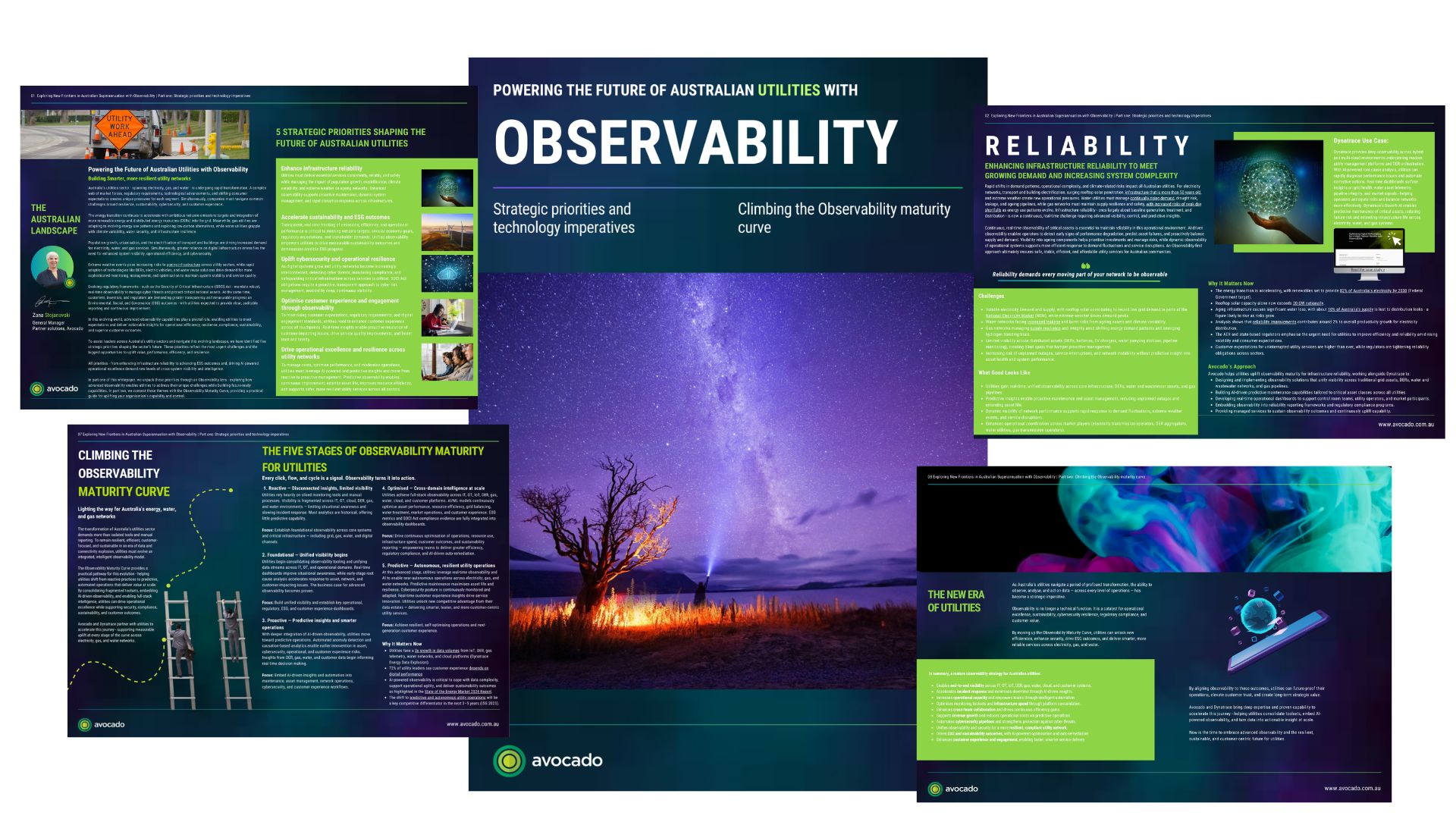Powering reliability in utilities: how Observability transforms customer and operational outcomes
For decades, utilities lived by a simple mantra: keep the lights on, keep the water flowing, keep the gas supply stable. But in today’s digital-first world, core service delivery is no longer enough. Customers expect accurate billing, seamless digital interactions, proactive communication during outages, and resilience in the face of disruption.
Trust is the new currency. And in utilities, it can be lost in an instant. A single billing error, portal login failure, or delayed outage notification sparks frustration, complaints, and even regulatory action. Unlike other industries, utilities rarely earn praise when things go right — but the moment something goes wrong, they are thrust into the spotlight.
The pain points holding utilities back
Many utilities still rely on fragmented systems, siloed monitoring, and manual processes. The result? Blind spots that let issues fester until customers – not IT teams – become the first line of defence.
Challenges we see most often fall into three areas:
1. Customer and Revenue Risk
- Billing errors and delays undermine trust and drive revenue leakage.
- Missed meter reads and failed digital processes cause inaccurate invoicing.
- Customers often detect portal or payment failures before IT teams do.
2. Operational Inefficiencies
- Manual checks drain resources while failures go unnoticed.
- Reactive firefighting increases stress, resolution times, and burnout.
- Knowledge silos slow collaboration and weaken resilience.
3. Technology and Security Gaps
- Limited visibility across hybrid cloud, SaaS, and legacy systems.
- Siloed monitoring makes root cause analysis slow and inconsistent.
- Failures in middleware, APIs, or batch jobs surface only when customers complain.
Why Observability is the answer
Traditional monitoring is no longer enough. Utilities need Observability – real-time, end-to-end visibility across infrastructure, applications, and business processes.
Observability makes it possible to:
- Detect issues earlier – spot anomalies before they reach the customer.
- Reduce billing errors – automate validation and minimise manual mismatches.
- Improve communication – align monitoring with business processes for accurate, real-time updates.
- Strengthen compliance – ensure incident response and reporting obligations are met.
- Build loyalty – consistent, proactive service strengthens confidence.
Real-world examples
Improved Customer Experience
One major utility we worked with struggled with login errors, payment failures, and unexplained billing inaccuracies. Despite having monitoring tools, they were fragmented and reactive. Problems were often discovered only after frustrated customers logged tickets – fuelling dissatisfaction, rising support costs, and regulatory risk.
By implementing an observability framework, powered by Dynatrace and Avocado’s expertise, the utility transformed its operations:
- Established end-to-end visibility across both legacy billing apps and cloud portals.
- Proactively flagged API delays, failed jobs, and backend disconnects.
- Introduced business-aligned dashboards for executives and engineers.
- Automated health checks, freeing staff from manual oversight.
- Reduced mean time to detect (MTTD) and resolve (MTTR), cutting complaints dramatically.
The result: improved resilience, lower costs, and measurable financial benefits.
Improved Incident Response
Horizon Power’s customer story is a powerful example of observability at work. Serving Australia’s largest catchment area -spanning 2.3 million km² of remote Western Australia -the utility adopted Dynatrace to visualise a complex mix of applications, infrastructure, and services and to replace traditional, siloed monitoring. Traditional monitoring fell short in their complex environment, slowing issue diagnosis and, in turn, stalling innovation and time-to-value. With full-stack observability and automated root-cause analysis, teams now identify issues in seconds rather than days, reduce firefighting, and prioritise fixes based on customer and financial impact. Shared, real-time dashboards have tightened alignment with internal squads and partners, helping Horizon Power deliver more reliable energy to regional communities while freeing capacity to innovate.
The result?
- Incident response accelerated – root cause in seconds, not days
- Lower operational stress – fewer firefighting cycles, more time to innovate
- Stronger partner alignment – shared dashboards build trust with third parties
- Sharper business insight – precise view of the monetary cost of issues to prioritise remediation
From firefighting to foresight
The shift to observability is more than an IT upgrade – it’s a business transformation. It means:
- Moving from firefighting to predicting and preventing issues.
- Embedding institutional knowledge into dashboards, reducing dependence on a handful of experts.
- Connecting IT telemetry directly to customer trust and regulatory obligations.
- Running 24/7 operations with confidence.
The strategic imperative
In today’s utility landscape, visibility is no longer optional. It underpins customer trust, compliance, and competitive advantage.
Utilities that embrace observability can:
- Deliver accurate, reliable billing.
- Detect and resolve outages before they escalate.
- Provide real-time updates to customers and regulators.
- Safeguard revenue while reducing operational costs.
- Strengthen resilience across increasingly complex environments.
Those that don’t risk higher costs, reputational damage, and regulatory exposure.
Building a future of trust and resilience
Customer experience – from billing accuracy to outage response – is now inseparable from operational excellence.
By combining Avocado’s sector expertise with Dynatrace’s AI-powered platform, utilities can finally light up the dark corners of their operations. They can automate responses, link IT telemetry to business outcomes, and deliver the certainty that customers and regulators demand.
Because in utilities, keeping the lights on is no longer enough. Keeping customer trust switched on is the new benchmark.
Explore the strategic priorities for utilities
Customer experience is just one of the pressures shaping the sector. Our whitepaper, [Exploring New Frontiers in Utilities with Observability], unpacks the five strategic priorities utilities must tackle – and how to overcome them.
Related Insights
The rise of multicloud environments, microservices, and containerised architectures has created an ever-growing web of interconnected systems that can be overwhelming to manage, especially at scale. This ‘Complexity Wall is a real problem – learn how modern cloud Observability is helping overcome these issues in this eBook:













